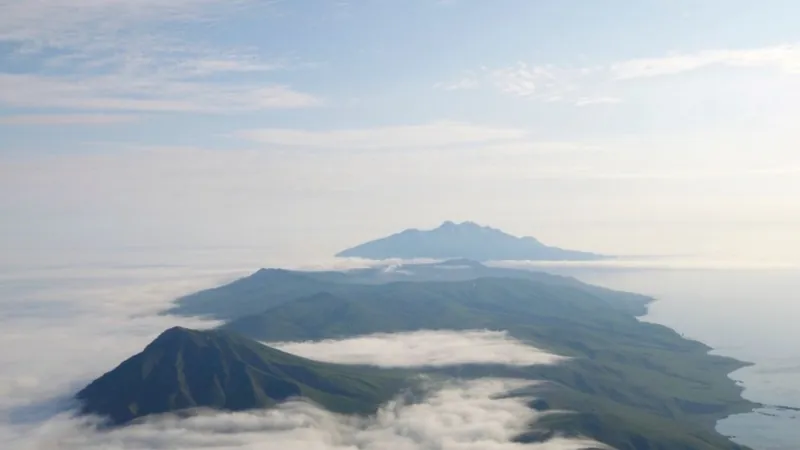
Unveiling the Secrets of the 1831 Eruption: How a Remote Volcano Turned the Sun Blue
2025-01-06
Author: Nur
Groundbreaking Discovery
Researchers have made a groundbreaking discovery about a volcanic eruption from 200 years ago that had a profound impact on our climate, causing the sun to appear blue and lowering temperatures across the Northern Hemisphere.
The Eruption's Impact
In 1831, the world experienced a chilling average temperature drop of approximately 1.8 degrees Fahrenheit (1 degree Celsius). This dramatic alteration coincided with widespread reports of dreary weather and unusual changes in sunlight. While it was long suspected that a massive eruption was the cause, the specific volcano remained elusive—until now.
The Zavaritskii Volcano
A team of scientists, led by volcanologist William Hutchison from the University of St Andrews in the U.K., traced this significant eruption back to the Zavaritskii volcano on the isolated Simushir Island, part of the strategically contested Kuril Islands situated between Russia and Japan. Historically, this island has been shrouded in mystery, especially during the Cold War, when the Soviet Union utilized a flooded volcanic crater as a covert nuclear submarine base.
Research Findings
The researchers' findings, published in the Proceedings of the National Academy of Sciences (PNAS), reveal a shocking gap in our understanding of volcanic activity in the Kuril Islands. "It was completely off the radar," Hutchison admitted, emphasizing the surprise that a relatively recent eruption could have gone unnoticed.
Little Ice Age Connection
The eruption of 1831 is linked to the final phase of the Little Ice Age (1800-1850), a period marked by significant climatic cooling but not an actual ice age. This era represents the coldest stretch humans have endured in the past five centuries.
Indirect Evidence of the Eruption
With no direct eyewitness accounts available from the eruption—likely due to the island's remoteness and frequent fog—scientists relied on indirect evidence of the eruption's impact. Notably, famous German composer Felix Mendelssohn noted "desolate weather" during his travels through the Alps that summer, comparing the cold to winter conditions. Reports from around the Northern Hemisphere described breathtakingly transformed skies, with colors ranging from blue to purple to green due to the scattering of light by aerosols from the volcanic eruption, echoing phenomena seen after the infamous Krakatoa eruption in 1883.
Broader Repercussions
The repercussions of this massive eruption were not merely atmospheric; they may have led to devastating famines in India and Japan during the 1830s—an alarming reminder of the connection between volcanic activity, climatic shifts, and human sustenance. "When you have cooling temperatures, rainfall patterns shift, and crop yields suffer, leading to food shortages," Hutchison explained.
Pinpointing the Eruption Source
To pinpoint the eruption's source, the research team meticulously analyzed ash samples deposited in polar ice cores from Greenland, dating back to the 19th century. The ash's chemical signatures aligned closely with that of the Zavaritskii volcano, ultimately culminating in a "Eureka" moment for the researchers akin to solving a forensic case. "It was one of the best days I've ever had in the lab," Hutchison noted with enthusiasm.
Need for Modern Monitoring
Despite resolving the enigma of the 1831 eruption, Hutchison cautioned about a lack of modern instrumentation to monitor volcanic activity in places like the Kuril Islands. "If a similar eruption were to occur today, our preparedness would not be significantly improved from 1831," he stated. This brings to light a broader concern: the challenge of predicting future climate-altering eruptions in our ever-changing world.
Conclusion
As we delve deeper into the history of these volcanic events, the implications for climate science and disaster preparedness are profound. What other secrets might remote locations still be hiding? Stay tuned as we uncover more Earth-shattering revelations!
 Brasil (PT)
Brasil (PT)
 Canada (EN)
Canada (EN)
 Chile (ES)
Chile (ES)
 Česko (CS)
Česko (CS)
 대한민국 (KO)
대한민국 (KO)
 España (ES)
España (ES)
 France (FR)
France (FR)
 Hong Kong (EN)
Hong Kong (EN)
 Italia (IT)
Italia (IT)
 日本 (JA)
日本 (JA)
 Magyarország (HU)
Magyarország (HU)
 Norge (NO)
Norge (NO)
 Polska (PL)
Polska (PL)
 Schweiz (DE)
Schweiz (DE)
 Singapore (EN)
Singapore (EN)
 Sverige (SV)
Sverige (SV)
 Suomi (FI)
Suomi (FI)
 Türkiye (TR)
Türkiye (TR)
 الإمارات العربية المتحدة (AR)
الإمارات العربية المتحدة (AR)